The Morphology and Differentiation of the Content of International Debate on Renewable Energy. A Bibliometric Analysis of Web of Science, Scopus, and Twitter
Abstract
:1. Introduction
2. Materials and Methods
2.1. Bibliometric Analysis
2.2. Twitter Analysis
3. Results
- Most prolific authors;
- Top themes and keywords;
- Co-occurrence of keywords.
3.1. Most Prolific Authors
3.2. Top Themes and Keywords
- The overwhelming majority of articles on RE and RES in social sciences were written by authors from China (21.2%) and the USA (19.4%). This conclusion is significantly correlated with the use of renewable energy in both countries: China and the USA are the world’s leaders in RES investment;
- A smaller group of authors is represented by India (14.8%), the UK (9.9%), Germany (9.6%), and Spain (9.5%). In total, authors from six countries published 2060 indexed articles in Scopus and WoS (84.32). This is a significant conclusion from a cognitive perspective and a key element of debates on data and its interpretation. It points to a visible concentration of research studies and a certain asymmetry in the distribution of publications by country;
- A group of 20 authors published from 6 to 13 indexed articles in both databases, and six researchers published 10–13 articles (most prolific authors);
- Out of 1598 Twitter users, only 268 (16.8%) had a verified account, confirming its authenticity. This is an important fact—both from a formal and methodological perspective. It indicates that we need to be cautious in our interpretations and assessments. In the analysed period, more than 600 hashtags of #renewableenergy were added to tweets by three users, who had from 491 to 2671 followers. The analysis of geographical locations points to the absence of tweets (or, possibly, the fact of hiding these locations) posted by Twitter users from China. This observation can be considered from the perspective of the domination of Chinese authors in scientific publications;
- The analysis of the co-occurrence of keywords in articles’ titles and abstracts leads to the conclusion that top themes and keywords are as follows: renewable energy (495 occurrences), energy transition (72), sustainable development (65), and energy consumption (52). Similar results are obtained from the analysis of abstracts;
- The cluster analysis of 968 keywords with more than 45 repetitions (excluding geographical names) leads to the identification of seven clusters. Keywords expressed positive narration, relating to new technologies, ecology, agriculture and production, hydrology and urban development, counteracting threats, and analytical methods. On a limited scale, keywords related to negative phenomena were found in clusters connected with ecology and the necessity to counteract threats;
- The comparison of keywords in articles and tweets and the identification of the degree of co-occurrence in both databases were based on chi-2 analysis. Regression analysis indicated a moderate correlation between keywords in articles and hashtags (coefficient of determination R2 = 0.169). Interestingly (and importantly from a scientific perspective), the coefficient of determination has a similar value in the case of a more reasonable distribution of residuals if, instead of the counts of hashtags, their logarithm is taken into account. This observation can indicate that the frequency of the occurrence of hashtags increases exponentially.
4. Discussion
5. Conclusions
Author Contributions
Funding
Institutional Review Board Statement
Conflicts of Interest
References
- Mohtasham, J. Review Article-Renewable Energies. Energy Procedia 2017, 74, 1289–1297. [Google Scholar] [CrossRef] [Green Version]
- Pettenger, M.E. The Social Construction of Climate Change; Routledge: London, UK, 2007. [Google Scholar]
- Potrč, S.; Čuček, L.; Martin, M.; Kravanja, Z. Sustainable renewable energy supply networks optimization—The gradual transition to a renewable energy system within the European Union by 2050. Renew. Sustain. Energy Rev. 2021, 146, 111186. [Google Scholar] [CrossRef]
- de La Cruz-Lovera, C.; Perea-Moreno, J.; de La Cruz-Fernandez, L.; Montoya, F.; Alcayde, A.; Manzano-Agugliaro, F. Analysis of research topics and scientific collaborations in energy saving using bibliometric techniques and community detection. Energies 2019, 12, 2030. [Google Scholar] [CrossRef] [Green Version]
- Harjanne, A.; Korhonen, J.M. Abandoning the concept of renewable energy. Energy Policy 2019, 127, 330–340. [Google Scholar] [CrossRef] [Green Version]
- Daly, H. Beyond Growth. In The Economics of Sustainable Development; Beacon Press: Boston, MA, USA, 1996. [Google Scholar]
- Abramovay, R. Beyond the Green Economy; Routledge: London, UK, 2016. [Google Scholar]
- Degarmo, D. International Environmental Traties and State Behavior: Factors Influencing Cooperation; Routledge: London, UK, 2015. [Google Scholar]
- Nordhaus, W. The Climate Casino: Risk, Uncertainty, and Economics for a Warming World; Yale University Press: New Haven, CT, USA, 2013. [Google Scholar]
- Maslin, M. Global Warming: A Very Short Introduction; OUP: Oxford, UK, 2008. [Google Scholar]
- Vogler, J. Climate Change in World Politics; Palgrave MacMillan: London, UK, 2016. [Google Scholar]
- Kamran, M.; Fazal, M.R. Renewable Energy Conversion Systems; Academic Press: London, UK, 2021. [Google Scholar]
- MacKay, D.J.C. Sustainable Energy—Without the Hot Air; UIT Cambridge: Cambridge, UK, 2008. [Google Scholar]
- Comparing Renewable Energy Policies in Europe. Available online: https://cicero.oslo.no/en.remix (accessed on 10 August 2021).
- Fanzo, J. A Path to Sustainable Food Systems. Curr. Hist. 2021, 120, 313–319. [Google Scholar] [CrossRef]
- Gernaat, D.E.H.J.; de Boer, H.S.; Daioglou, V.; Yalwe, S.G.; Müller, C.; van Vuuren, D.P. Climate change impacts on renewable energy supply. Nat. Clim. Chang. 2021, 11, 119–125. [Google Scholar] [CrossRef]
- Keohane, R.O. The Global Politics of Climate Change: Chalenge for Political Science. Political Sci. 2012, 48, 19–26. [Google Scholar] [CrossRef] [Green Version]
- Moser, S.; Kleinhückelkotten, S. Good Intents, but Low Impacts: Diverging Importance of Motivational and Socioeconomic Determinants Explaining Pro-Environmental Behavior, Energy Use, and Carbon Footprint. Environ. Behav. 2018, 50, 626–656. [Google Scholar] [CrossRef] [Green Version]
- Kahan, D.M.; Corbin, J.C. The Polarizing Impact of Science Literacy and Numeracy on Perceived Climate Change Risk. Nat. Clim. Chang. 2012, 2, 732–735. [Google Scholar] [CrossRef] [Green Version]
- He, L.; Zhang, S.; Chen, Y.; Ren, L.; Li, J. Techno-economic potential of a renewable energy-based microgrid system for a sustainable large-scale residential community in Beijing, China. Renew. Sustain. Energy Rev. 2018, 93, 631–641. [Google Scholar] [CrossRef]
- Ropuszyńska-Surma, E.; Węglarz, M. Profiling End User of Renewable Energy Sources among Residential Consumers in Poland. Sustainability 2018, 10, 4452. [Google Scholar] [CrossRef] [Green Version]
- Gródek-Szostak, Z.; Suder, M.; Kusa, R.; Szeląg-Sikora, A.; Duda, J.; Niemiec, M. Renewable Energy Promotion Instruments Used by Innovation Brokers in a Technology Transfer Network. Case Study of the Enterprise Europe Network. Energies 2020, 13, 3445. [Google Scholar] [CrossRef]
- Scarpa, R.; Willis, K. Willingness-to-pay for renewable energy: Primary and discretionary choice of British households’ for micro-generation technologies. Energy Econ. 2010, 32, 129–136. [Google Scholar] [CrossRef]
- Sanderink, L.; Nasiritousi, N. How institutional interactions can strengthen e_ectiveness: The case of multi-stakeholder partnerships for renewable energy. Energy Policy 2020, 141, 111447. [Google Scholar] [CrossRef]
- The Intergovernmetal Panel on Climate Change, IPCC. Available online: https://www.ipcc.ch/ (accessed on 8 August 2021).
- IRENA. Available online: http://www.irena.org/irenamembership (accessed on 6 August 2021).
- Barrett, A. Stability of Zero-growth Economics Analysed with a Minskyan Model. Ecol. Econ. 2018, 146, 228–239. [Google Scholar] [CrossRef]
- Our Common Future. Report of the World Commission on Environment and Development. Available online: http://www.un-documents.net/our-common-future.pdf (accessed on 5 August 2021).
- United Nations Framework Convention on Climate Change. Available online: https://treaties.un.org/Pages/ViewDetailsIII.aspx?src=IND&mtdsg_no=XXVII-7&chapter=27&Temp=mtdsg3&clang=_en (accessed on 10 August 2021).
- Kyoto Protocol—Targets for the First Commitment Period. Available online: https://unfccc.int/process-and-meetings/the-kyoto-protocol/what-is-the-kyoto-protocol/kyoto-protocol-targets-for-the-first-commitment-period (accessed on 10 August 2021).
- Paris Agreement. Report of the Conference of the Parties to the United Nations Framework Convention on Climate Change. Available online: https://unfccc.int/resource/docs/2015/cop21/eng/10.pdf (accessed on 28 September 2021).
- Adoption of the Paris Agreement. Available online: https://unfccc.int/resource/docs/2015/cop21/eng/l09r01.pdf (accessed on 28 September 2021).
- The Sustainable Development Goals, SDG. Available online: http://www.un.prg.esa/ff.dwp-content/uploads/2015/08/AAAAOutcome.pdf (accessed on 5 August 2021).
- Shindell, D.; Faluvegi, G.; Seltzer, K.; Shindell, C. Quantified, localized health benefits of accelerated carbon dioxide emissions reductions. Nature Clim. Chang. 2018, 8, 291–295. [Google Scholar] [CrossRef] [PubMed]
- Raftery, A.; Zimmer, A.; Frierson, D.; Startz, R.; Liu, P. Less than 2 °C warming by 2100 unlikely. Nat. Clim. Chang. 2017, 7, 637–641. [Google Scholar] [CrossRef] [PubMed]
- Rogelj, J.; den Elzen, M.; Höhne, N.; Fransen, T.; Fekete, H.; Winkler, H.; Schaeffer, R.; Sha, F.; Riahi, K.; Meinshausen, M. Paris Agreement climate proposals need a boost to keep warming well below 2 °C. Nature 2016, 534, 631–639. [Google Scholar] [CrossRef] [PubMed] [Green Version]
- Goldstein, J.S.; Qvist, S.A. A Brigth Future: How Some Countries Have Solved Climate Change and the Rest Can Follow; Public Affairs: New York, NY, USA, 2019. [Google Scholar]
- Wallace-Wells, D. The Uninhabitable Earth. Life after Warming; Tim Duggan Books: New York, NY, USA, 2019. [Google Scholar]
- Sustainable Development Indicators. Available online: https://ec.europa.eu/eurostat/web/sdi/overview (accessed on 5 August 2021).
- Renewables, Fuels and Technologies. Available online: https://www.nrel.gov/learning/re_basics.html (accessed on 28 September 2021).
- Renewable Energy Directive on the Promotion of the Use of Energy from Renewable Sources and Amending and Subsequently Repealing. Available online: https://eur-lex.europa.eu/LexUriServ/LexUriServ.do?uri=OJ:L:2009:140:0016:0062:en:PDF (accessed on 28 September 2021).
- Report from the Commission to the European Parliament, the Council, The European Economic and Social Committee, and the Committee of the Regions. Available online: https://eur-lex.europa.eu/legal-content/EN/ALL/?uri=CELEX%3A52013DC0175 (accessed on 28 September 2021).
- Renewables 2021 Global Status Report, Renewable Energy Policy Network for the 21st Century. Available online: https://www.bp.com/content/dam/bp/business-sites/en/global/corporate/pdfs/energy-economics/statistical-review/bp-stats-review-2019-full-report.pdf (accessed on 6 August 2021).
- BP Statistical World Energy Review. Available online: https://www.bp.com/content/dam/bp/business-sites/en/global/corporate/xlsx/energy-economics/statistical-review/bp-stats-review-2019-all-data.xlsx (accessed on 6 August 2021).
- Renewables 2021, Global Status Report. Available online: https://www.ren21.net/wp-content/uploads/2019/05/GSR2021_Full_Report.pdf (accessed on 6 August 2021).
- Prokopenko, O.; Chechel, A.; Sotnyk, I.; Omelyanenko, V.; Kurbatova, T.; Nych, T. Improving state support schemes for the sustainable development of renewable energy in Ukraine. Polityka Energetyczna 2021, 24, 85–100. [Google Scholar] [CrossRef]
- Ragwitz, M.; Steinhilber, S. Effectiveness and efficiency of support schemes for electricity from renewable energy sources. Wiley Interdiscip. Rev. Energy Environ. 2014, 3, 213–229. [Google Scholar] [CrossRef]
- Directive 2009/28/EC of the European Parliament and of the Council of 23 April 2009 on the Promotion of the Use of Energy from Renewable Sources and Amending and Subsequently Repealing Directives 2001/77/EC and 2003/30/EC. Available online: http://data.europa.eu/eli/dir/2009/28/oj (accessed on 7 August 2021).
- Fit for 55’: Delivering the EU’s 2030 Climate Target on the Way to Climate Neutrality. Available online: https://eur-lex.europa.eu/legal-content/EN/TXT/?uri=CELEX%3A52021DC0550 (accessed on 7 August 2021).
- European Commission. 2050 Long-Term Strategy. Available online: https://ec.europa.eu/clima/policies/strategies/2050_en (accessed on 10 August 2021).
- Klein, N. This Changes Everything: Capitalism vs. the Climate; Simon & Schuster: New York, NY, USA, 2014. [Google Scholar]
- Chapman, D.A.; Lickel, B.; Markowitz, E.M. Reassessing emotion in climate change communication. Nat. Clim. Chang. 2017, 7, 850–852. [Google Scholar] [CrossRef]
- Progress towards the Sustainable Development Goals, Report of the Secretary-General. Available online: https://www.un.org/ga/search/view_doc.asp?symbol=E/2017/66&Lang=E (accessed on 6 August 2021).
- Haas, R.; Panze, C.; Resch, G.; Ragwitz, M.; Reece, G.; Held, A. A historical review of promotion strategies for electricity from renewable energy sources in EU countries. Renew. Sustain. Energy Rev. 2011, 15, 1003–1034. [Google Scholar] [CrossRef]
- Haas, P.M. Introduction: Ecpistemic Communities and International Policy Coordination. Int. Organ. 1992, 46, 1–35. [Google Scholar] [CrossRef] [Green Version]
- World Wildlife Fund WWF. The Energy Report—100% Renewable Energy by 2050; WWF International: Gland, Switzerland, 2011. [Google Scholar]
- Long-Term Strategy for 2050–A Clean Planet for All. Available online: https://ease-storage.eu/news/long-term-strategy-2050/ (accessed on 10 August 2021).
- Project Stanford University—Global Climate & Energy Project. Available online: http://gcep.stanford.edu/research/index.html (accessed on 6 August 2021).
- International Energy Outlook 2017 (i 2050). Available online: https://www.eia.gov/outlooks/ieo/pdf/0484(2017).pdf (accessed on 8 August 2021).
- Eurostat. Renewable Energy Statistics. Available online: https://ec.europa.eu/eurostat/statistics-explained/index.php?title=Renewable_energy_statistics (accessed on 10 August 2021).
- Anderegg, W.R.L.; James, W.; Prall, J.W.; Harold, J.; Schneider, S.H. Expert credibility in climate change. Proc. Natl. Acad. Sci. USA 2010, 107, 12107–12109. [Google Scholar] [CrossRef] [PubMed] [Green Version]
- Mathers, C. Calorie Restriction and Longer life in Nematode Worms. Available online: https://colinmathers.com/2014/06/27/calorie-restriction-and-longer-life-in-nematode-worms/ (accessed on 8 August 2021).
- Climate Change Widespread, Rapid, and Intensifying. Available online: https://www.ipcc.ch/2021/08/09/ar6-wg1-20210809-pr/ (accessed on 10 August 2021).
- Hoffman, D.L.; Novak, T.P. Marketing in Hypermedia Computer-Mediated Environments: Conceptual Foundation. J. Mark. 1996, 60, 50–68. [Google Scholar] [CrossRef]
- McQuail, D. Mass Communication Theory; Sage Publication: Thousand Oaks, CA, USA, 2010. [Google Scholar]
- Streimikiene, D.; Kyriakopoulos, G.; Lekavicius, V.; Siksnelyte-Butkiene, I. Energy Poverty and Low Carbon Just Energy Transition: Comparative Study in Lithuania and Greece. Soc. Indic. Res. 2021, 1–53. [Google Scholar] [CrossRef]
- Anagnostopoulos, T.; Kyriakopoulos, G.L.; Ntanos, S.; Gkika, E.; Asonitou, S. Intelligent Predictive Analytics for Sustainable Business Investment in Renewable Energy Sources. Sustainability 2020, 12, 2817. [Google Scholar] [CrossRef] [Green Version]
- Ferrari, G.; Pezzuolo, A.; Nizami, A.-S.; Marinello, F. Bibliometric Analysis of Trends in Biomass for Bioenergy Research. Energies 2020, 13, 3714. [Google Scholar] [CrossRef]
- XiaoRong, H.; DeJian, Y. Bibliometric analysis of international cooperation in biomass energy research. Curr. Sci. 2019, 117, 1785–1793. [Google Scholar]
- Huaqi, C.; Ho, Y.S. Highly cited articles in biomass research: A bibliometric analysis. Renew. Sustain. Energy Rev. 2015, 49, 12–20. [Google Scholar]
- Kosch, O.; Szarucki, M. An overview of 25 years of European scientific collaboration in the field of strategic management: A bibliometric analysis. Eur. Manag. Rev. 2021, 18, 51–69. [Google Scholar] [CrossRef]
- Prichard, A. Statistical Bibliography or Bibliometrics? J. Doc. 1969, 25, 348–349. [Google Scholar]
- Grzybowska, K. Identification and Classification of Global Theoretical Trends and Supply Chain Development Directions. Energies 2021, 14, 4414. [Google Scholar] [CrossRef]
- Lis, A.; Sudolska, A.; Pietryka, I.; Kozakiewicz, A. Cloud Computing and Energy Efficiency: Mapping the Thematic Structure of Research. Energies 2020, 13, 4117. [Google Scholar] [CrossRef]
- Klincewicz, K.; Zemigła, M.; Mijał, M. Bibliometria w Zarządzaniu Technologiami i Badaniami Naukowymi; MniSzW: Warsaw, Poland, 2012.
- Nowak, P. Bibliometria. Webometria. Podstawy. Wybrane Zastosowania; Wydawnictwo Naukowe Uniwersytetu Adama Mickiewicza: Poznań, Poland, 2006. [Google Scholar]
- Narin, F.; Moll, J. Bibliometrics. Annu. Rev. Inf. Sci. Technol. 1977, 12, 35–58. [Google Scholar]
- With, H.D.; McCain, K.W. Bibliometrics. Annu. Rev. Inf. Sci. Technol. 1988, 24, 119–186. [Google Scholar]
- Nicholas, D.; Richtie, M. Literature and Bibliometrics; Bingley: London, UK, 1978. [Google Scholar]
- Kosch, O.; Szarucki, M. Transatlantic affiliations of scientific collaboration in strategic management: A quarter-century of bibliometric evidence. J. Bus. Econ. Manag. 2020, 21, 627–646. [Google Scholar] [CrossRef] [Green Version]
- Thelwall, M. A history of webometrics. Bull. Am. Soc. Inf. Sci. Technol. 2012, 38, 18–23. [Google Scholar] [CrossRef]
- Bradford, S.C. Sources of information on specyfic subject. Engineering 1934, 137, 85–86. [Google Scholar]
- Lotka, A.J. The frequency distribution of scientific productivity. J. Wash. Acad. Sci. 1926, 16, 317–324. [Google Scholar]
- Zipf, G.K. Human Behavior and the Principle of Least Effort. An Introduction to Human Ecology; Addison-Wesley Press: Cambridge, UK, 1949. [Google Scholar]
- Tarragona, J.; de Garcia, A.; Cabeza, L.F. Bibliometric analysis of smart control applications in thermal energy storage systems. A model predictive control approach. J. Energy Storage 2020, 32, 1017041–10170413. [Google Scholar] [CrossRef]
- Jiang, D.J.; Shi, B.I.; Ouyang, H.; Fan, Y.; Lin Wang, Z.; Chen, C.M.; Li, Z. A 25-year bibliometric study of implantable energy harvesters and self-powered implantable medical electronics researches. Mater. Today Energy 2020, 16, 100386. [Google Scholar] [CrossRef]
- Sarkodie, S.A.; Owusu, P.A. Bibliometric analysis of water–energy–food nexus: Sustainability assessment of renewable energy. Curr. Opin. Environ. Sci. Health 2020, 13, 29–34. [Google Scholar] [CrossRef]
- Brown, M.A.; Soni, A.; Doshi, A.D.; King, C. The persistence of high energy burdens: A bibliometric analysis of vulnerability, poverty, and exclusion in the United States. Energy Res. Soc. Sci. 2020, 70, 101756. [Google Scholar] [CrossRef]
- Calderón, A. Where is Thermal Energy Storage (TES) research going?—A bibliometric analysis. Solar Energy 2020, 200, 37–50. [Google Scholar] [CrossRef]
- Chen, H.-Q.; Wang, X.; He, L.; Chen, P.; Wan, Y.; Yang, L.; Jiang, S. Chinese energy and fuels research priorities and trend: A bibliometric analysis. Renew. Sustain. Energy Rev. 2016, 58, 966–975. [Google Scholar] [CrossRef]
- Wang, Y.; Lai, N.; Zuo, J.; Chen, G.; Du, H. Characteristics and trends of research on waste-to-energy incineration: A bibliometric analysis, 1999–2015. Renew. Sustain. Energy Rev. 2016, 66, 95–104. [Google Scholar] [CrossRef]
- Mao, G.; Liu, X.; Du, H.; Zuo, J.; Wang, L. Way forward for alternative energy research: A bibliometric analysis during 1994–2013. Renew. Sust. Energ. Rev. 2015, 48, 276–286. [Google Scholar] [CrossRef]
- Azevedo, S.G. Supply chain of renewable energy: A bibliometric review approach. Biomass Bioenergy 2019, 126, 70–83. [Google Scholar] [CrossRef]
- Payman, A.; Searcy, C.; Jaber, M.Y. Energy-related performance measures employed in sustainable supply chains: A bibliometric analysis. Sustain. Prod. Consum. 2016, 7, 1–15. [Google Scholar]
- Yu, H.; Wei, Y.; Tang, B.; Mi, Z.; Pan, S. Assessment on the research trend of low-carbon energy technology investment: A bibliometric analysis. Appl. Energy 2016, 184, 960–970. [Google Scholar] [CrossRef]
- Menéndez-Manjón, A.; Moldenhauer, K.; Wagener, P.; Barcikowski, S. Nano-energy research trends: Bibliometrical analysis of nanotechnology research in the energy sector. J. Nanopart. Res. 2011, 13, 3911–3922. [Google Scholar] [CrossRef]
- Paananen, A.; Makinen, S.J. Bibliometrics-based foresight on renewable energy production. Foresight 2013, 15, 465–476. [Google Scholar] [CrossRef]
- Corsini, F.; Certoma, C.; Dyer, M.; Frey, M. Participatory energy: Research, imaginaries and practices on people’ contribute to energy systems in the smart city. Technol. Forecast. Soc. Chang. 2018, 142, 322–332. [Google Scholar] [CrossRef]
- Zupic, I.; Čater, T. Bibliometric Methods in Management and Organization. Organ. Res. Methods 2015, 18, 429–472. [Google Scholar] [CrossRef]
- PRISMA Statement. Available online: http://prisma-statement.org/PRISMAStatement/CitingAndUsingPRISMA (accessed on 10 August 2021).
- Huang, Z.; Chen, H.; Liu, Z. The 100 top-cited systematic reviews/meta-analyses in central venous catheter research: A PRISMA-compliant systematic literature review and bibliometric analysis. Intensiv. Crit. Care Nurs. 2020, 57, 102803. [Google Scholar] [CrossRef] [PubMed]
- Chew, C.; Eysenbach, G. Pandemics in the Age of Twitter: Content Analysis of Tweets during the 2009 H1N1 Outbreak. PLoS ONE 2010, 5, e14118. [Google Scholar] [CrossRef] [PubMed]
- Öztürk, N.; Ayvaz, S. Sentiment analysis on Twitter: A text mining approach to the Syrian refugee crisis. Telemat. Inform. 2018, 35, 136–147. [Google Scholar] [CrossRef]
- Alsaeedi, A.; Zubair, M. A Study on Sentiment Analysis Techniques of Twitter Data. Int. J. Adv. Comput. Sci. Appl. 2019, 10, 2. [Google Scholar] [CrossRef] [Green Version]
- Khan, S. Qualitative Research Method: Grounded Theory. Int. J. Bus. Manag. 2014, 9, 224. [Google Scholar] [CrossRef] [Green Version]
- Schneiker, A. Telling the Story of the Superhero and the Anti-Politician as President: Donald Trump’s Branding on Twitter. Political Stud. Rev. 2019, 17, 210–223. [Google Scholar] [CrossRef]
- Ciechanowski, L.; Jemielniak, D.; Gloor, P. TUTORIAL: AI research without coding: The art of fighting without fighting: Data science for qualitative researchers. J. Bus. Res. 2020, 117, 322–330. [Google Scholar] [CrossRef]
- Hill, S.; Scott, R.A. Developing an Approach to Harvesting, Cleaning, and Analyzing Data from Twitter Using R. Inf. Syst. Educ. J. 2017, 15, 42–54. [Google Scholar]
- Kreft, J. Za Fasadą Społeczności. Elementy Zarzadzania Nowymi Mediami; Wydawnictwo Uniwersytetu Jagiellońskiego: Kraków, Poland, 2015. [Google Scholar]
- Castells, M. The Risk of the Network Society; Blackwell: Cambridge, MA, USA, 2009. [Google Scholar]
- Van Eck, N.J.; Waltman, L. Software survey: VOSviewer, a computer program for bibliometric mapping. Scientometrics 2010, 84, 523–538. [Google Scholar] [CrossRef] [PubMed] [Green Version]
- Aria, M.; Cuccurullo, C. Bibliometrix: An R-tool for comprehensive science mapping analysis. J. Informetr. 2017, 11, 959–975. [Google Scholar] [CrossRef]
- R Development Documentation. Available online: https://www.r-project.org/ (accessed on 10 August 2021).
- R: Collecting and Analyzing Twitter Data. Available online: https://mkearney.github.io/nicar_tworkshop/#1 (accessed on 10 August 2021).
- IPSOS. Climate Change: Citizens are Worried but Torn between a Need to Act and Rejection of Constraints. Available online: https://www.ipsos.com/en/climate-change-citizens-are-worried-torn-between-need-act-and-rejection-constraints (accessed on 13 August 2021).
- Pearl, J.; Mackenzie, D. The Book of Why: The New Science of Cause and Effect; Basic Books Pearl: New York, NY, USA, 2018. [Google Scholar]
- Almind, T.C.; Ingwersen, P. Informetric analyses on the world wide web: Methodological approaches to ‘webometrics’. J. Doc. 1997, 53, 404–426. [Google Scholar] [CrossRef] [Green Version]

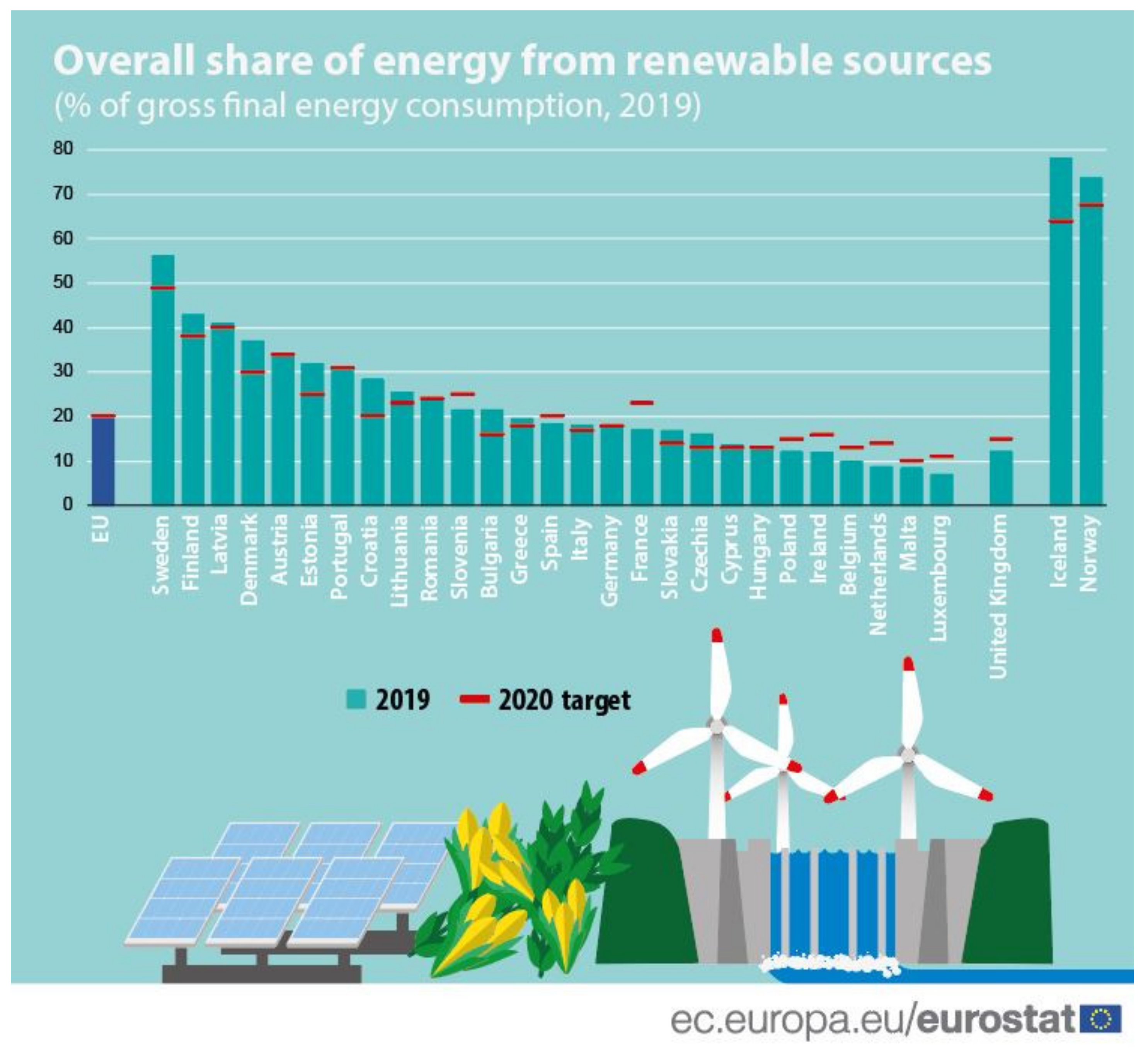

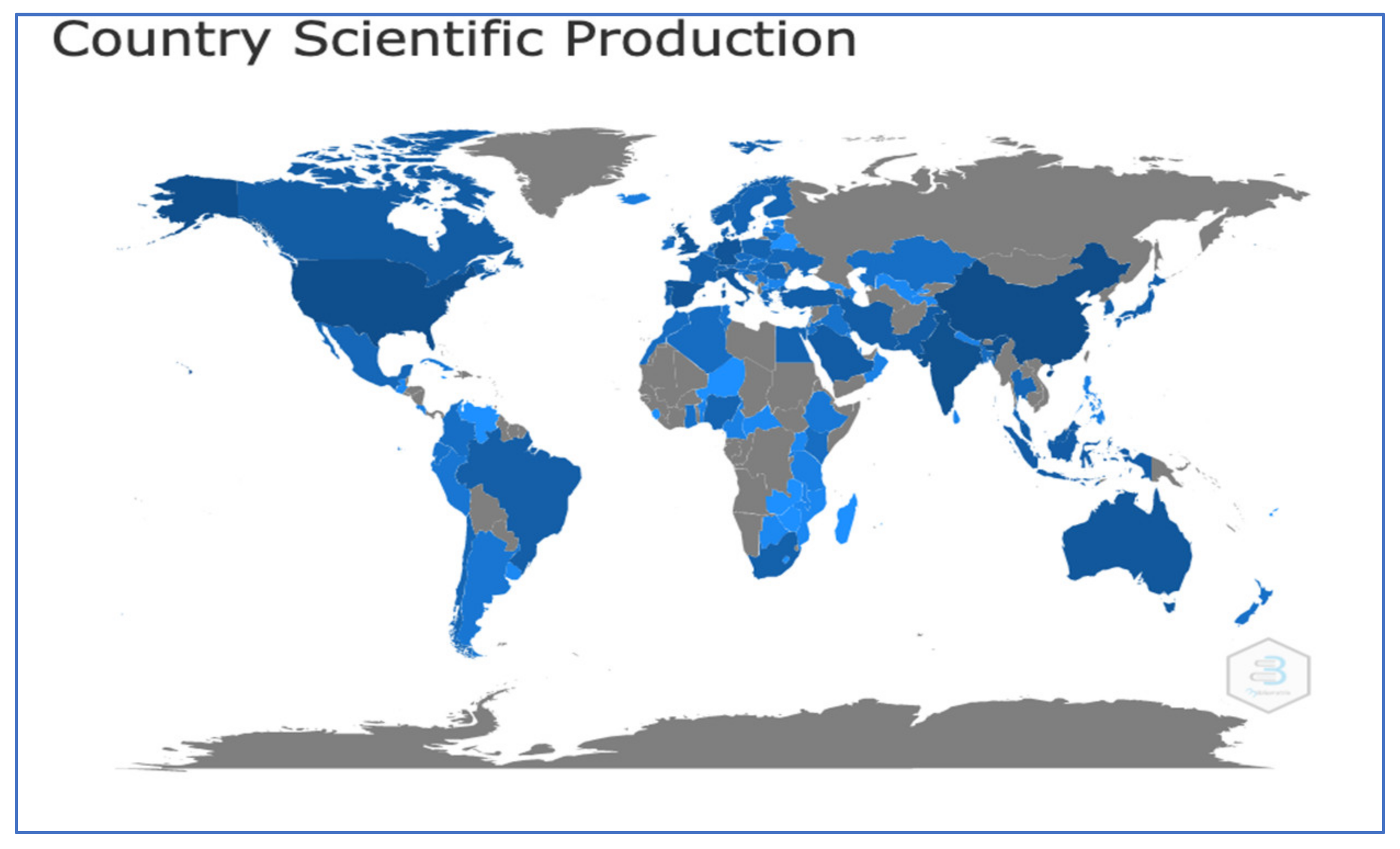
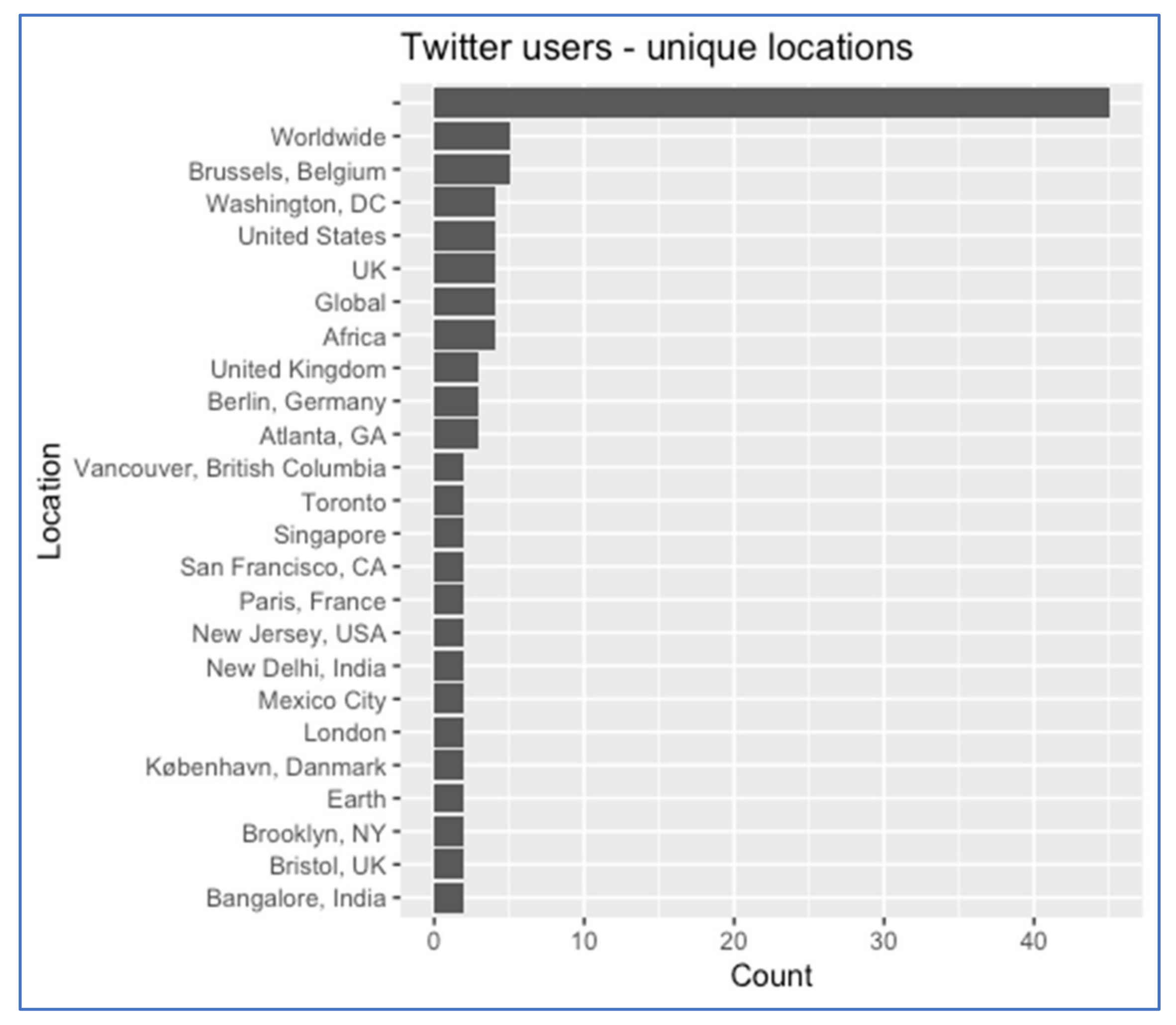

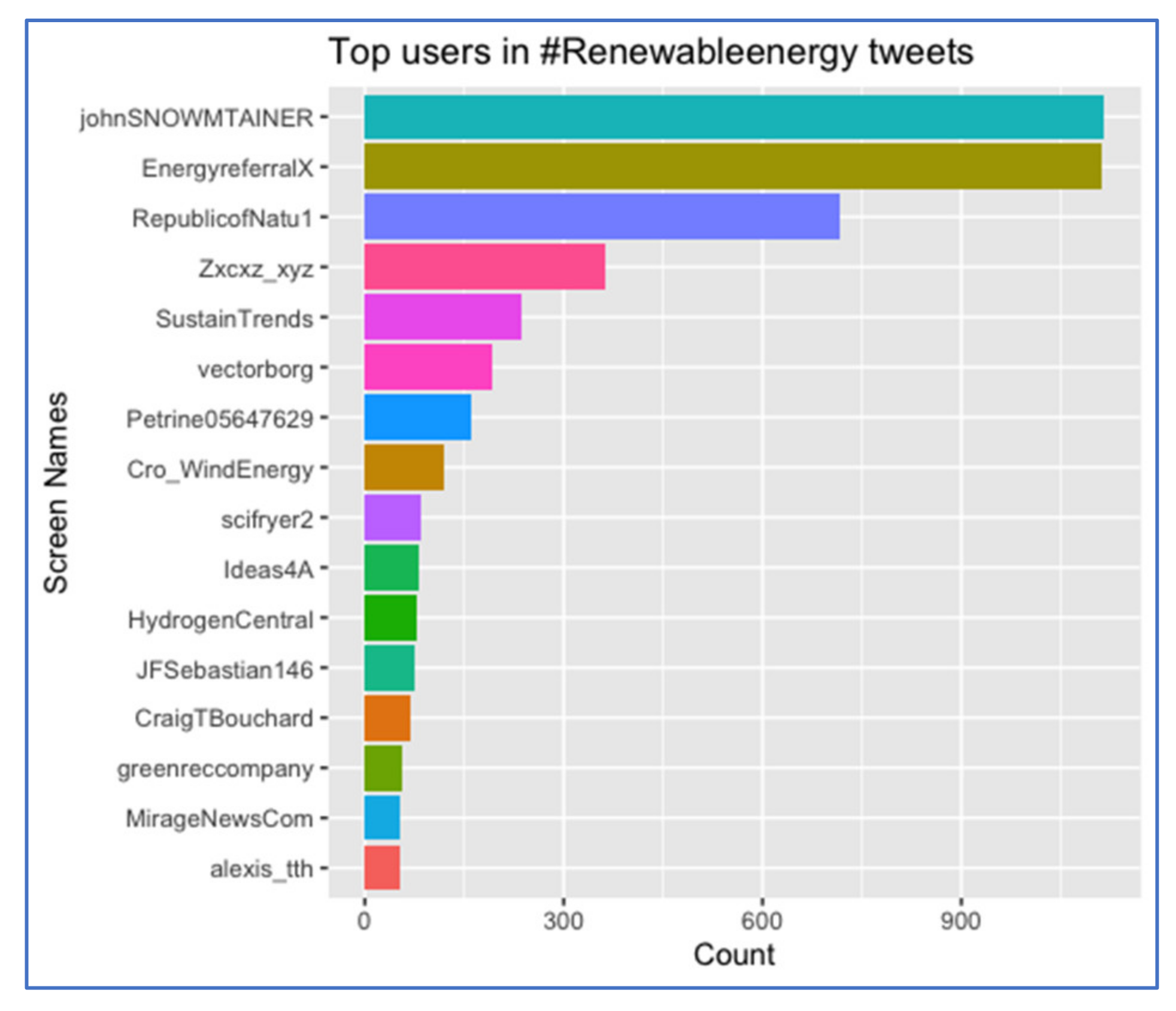

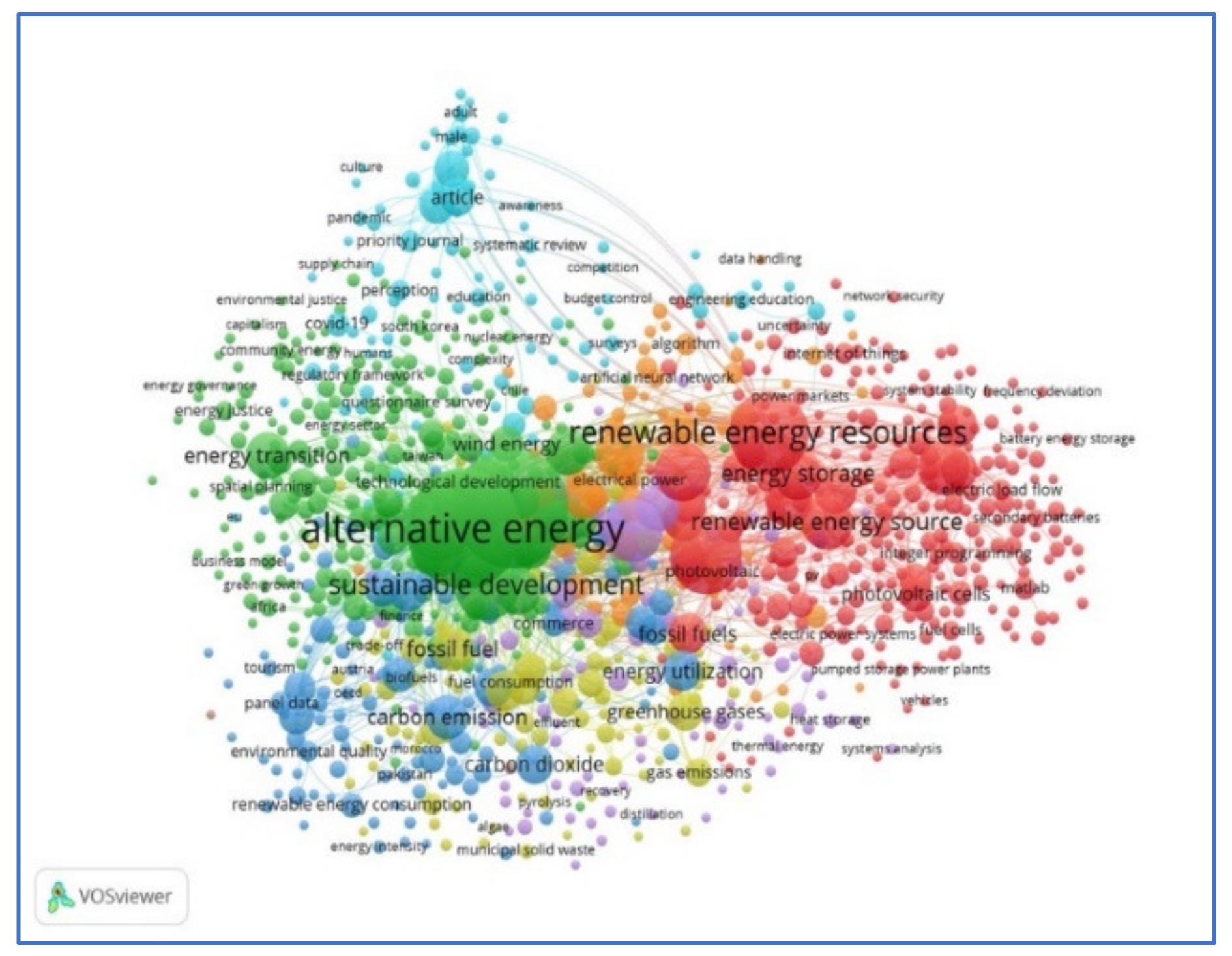
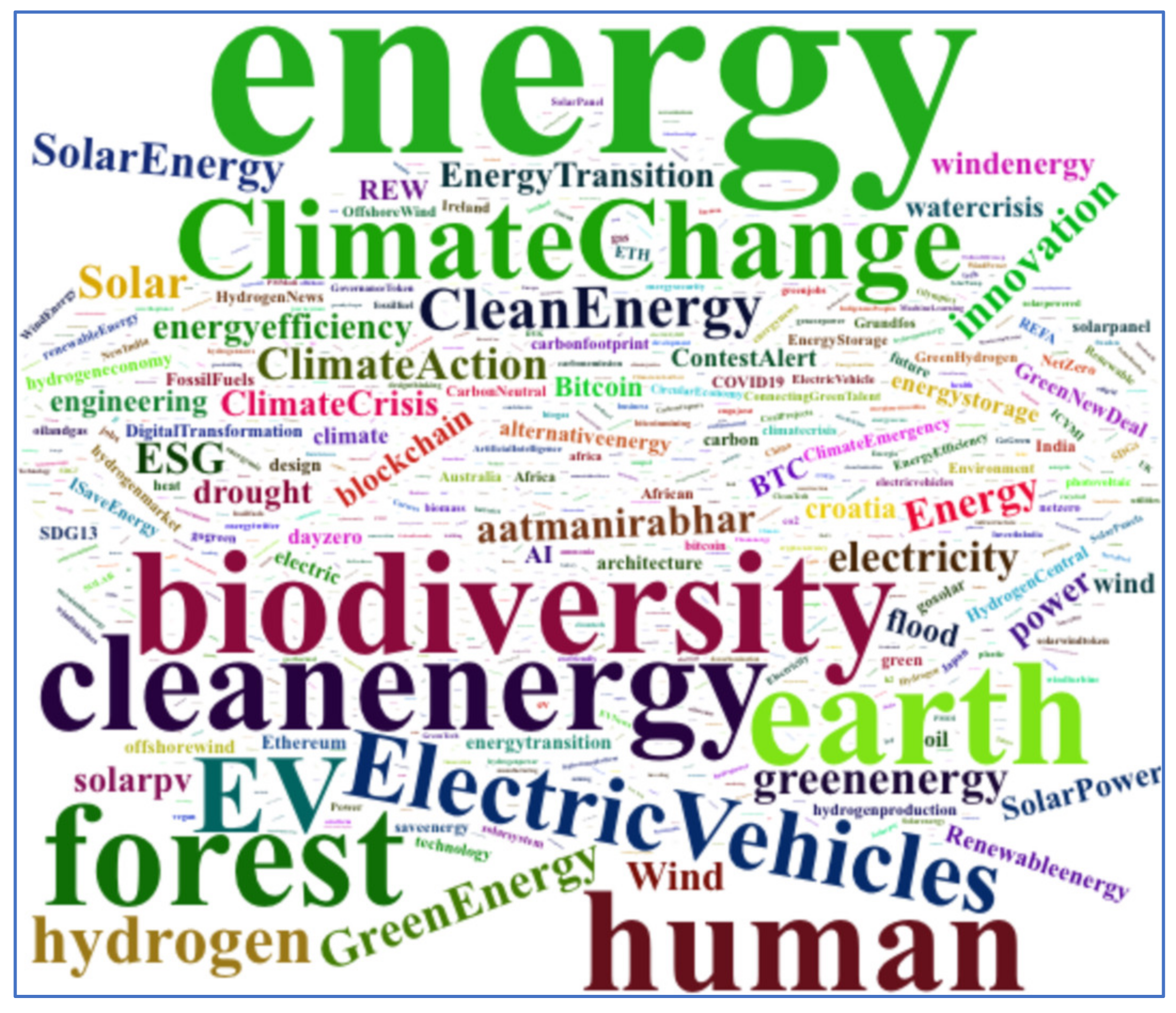

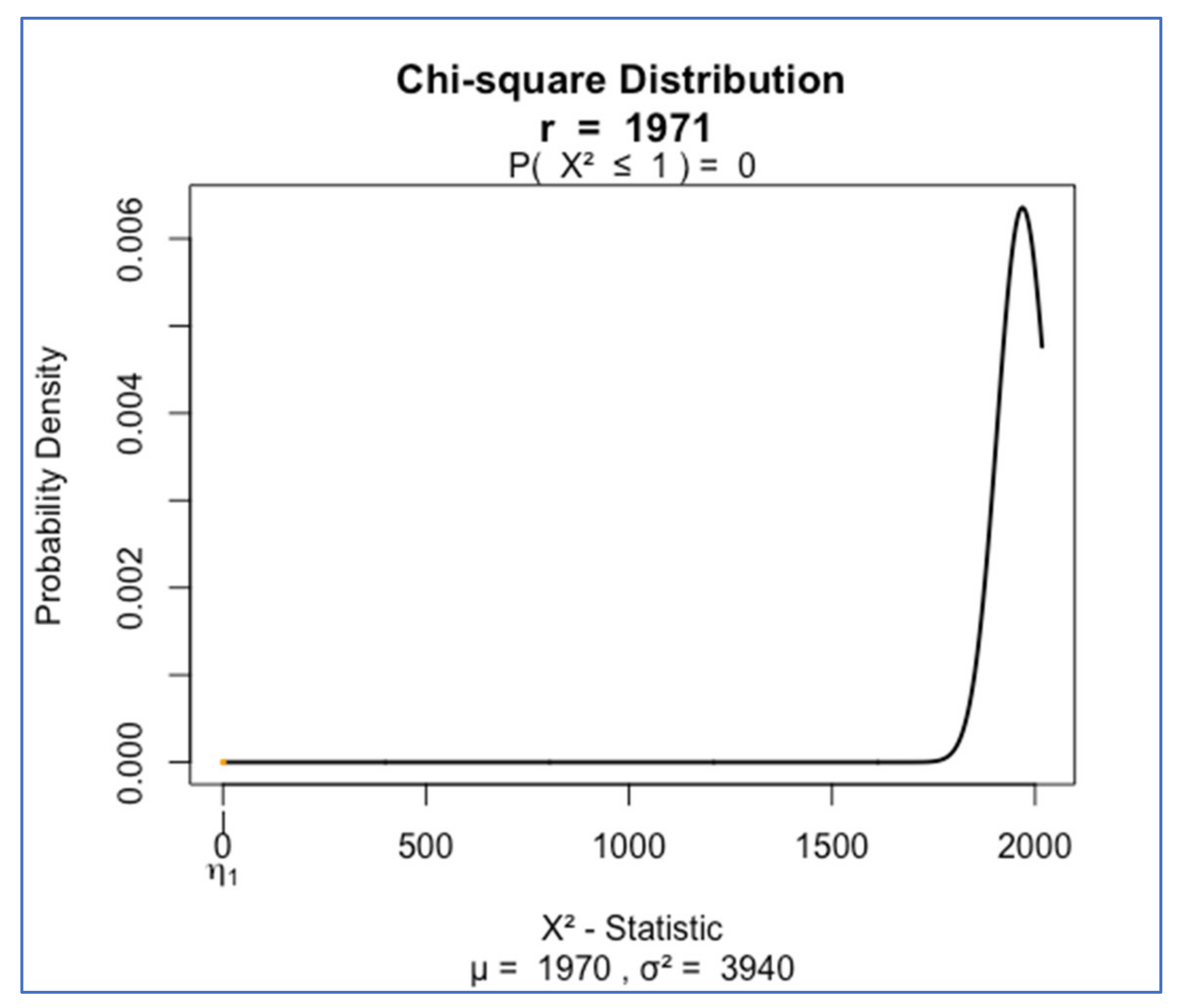

| Type of Renewable Energy | Source | Advantages | Disadvantages |
|---|---|---|---|
| Solar Energy | Sunlight | Infinite resource, environmentally friendly, works in many climates | Expensive and requires a lot of space, solar manufacturing is not good for the environment |
| Wind Energy | Wind | Low operational costs, efficient use of land space, renewable and clean source of energy | Noise and environmental problems, intermittent |
| Geothermal Energy | Underground heat of earth | Infinite resource | Limited only to volcanic areas, energy fluid needs to be pumped back into the underground reservoirs faster than it is depleted, management is required to maintain sustainability |
| Biomass Energy | Plant or animal waste | Cost effective and carbon neutral | Expensive and requires a lot of space |
| Hydropower (or Hydroelectric Power) | Gravitational force of failing or flowing water | Flexible and reliable | Expensive |
| Tidal Energy | Movement tide | Long lifespans, zero-carbon emissions, high power output | Expensive, environmental issue, limited site availability |
| Wave Energy | Movement of seawater | Environmentally friendly, reliable | Limited only to seaside and islands, expensive |
| Description | Scopus | Web of Science |
|---|---|---|
| Results in all scientific disciplines/all catalogues | 47,738 | 63,088 |
Results narrowed down to:
| 3323 (6.75%) | 7367 (11.68%) |
| Results after removal of duplicated records, incomplete records, and manual verification of disciplines | 1114 (33.52%) | 1329 (18.13%) |
| Results used in further bibliometric analysis | 2443 (2.20%) | |
| Tweets marked as hashtag #renewableenergy, published by Twitter from 15 to 27 July 2021 | 18,000 tweets |
| Number of unique Twitter users who use the hashtag #renewablenergy at least once in the analysed period | 1598 users |
| Number of analysed words | 448,116 |
| Number of analysed hashtags | 1124 |
| No. | Cluster | Examples of Keywords |
|---|---|---|
| 1 | Keywords related to technology (249 items) | Big data, blockchain, energy storage, biogas, biomasses, solar power, wind power, electric power, hybrid power systems |
| 2 | Keywords related to social issues and social changes (246 items) | Action plan, business development, business models, climate change, community development, law, governance approach |
| 3 | Keywords related to ecology (115 items) | Carbon emission, coal industry, ecological footprints, environmental degradation, pollution, destruction, negative effects |
| 4 | Keywords related to agriculture and production (102 items) | Agricultural emission, agricultural robots, anaerobic digestion, greenhouse gases, recycling, life cycles, waste treatment |
| 5 | Keywords related to hydrology and urban development (95 items) | Ground water, housing, hydroelectric power, photovoltaic, residential building, residential energy, urban growth, water supply, zero energy buildings |
| 6 | Keywords related to education and the necessity to counteract threats (95 items) | Controlled study, data mining, e-learning, education, engineering education, future research direction, health care policy |
| 7 | Keywords related to analytical methods (66 items) | Artificial neural networks, cluster analysis, data handling, fuzzy logic, machine learning, trend analysis |
Publisher’s Note: MDPI stays neutral with regard to jurisdictional claims in published maps and institutional affiliations. |
© 2021 by the authors. Licensee MDPI, Basel, Switzerland. This article is an open access article distributed under the terms and conditions of the Creative Commons Attribution (CC BY) license (https://creativecommons.org/licenses/by/4.0/).
Share and Cite
Sanak-Kosmowska, K.; Wiktor, J.W. The Morphology and Differentiation of the Content of International Debate on Renewable Energy. A Bibliometric Analysis of Web of Science, Scopus, and Twitter. Energies 2021, 14, 7094. https://doi.org/10.3390/en14217094
Sanak-Kosmowska K, Wiktor JW. The Morphology and Differentiation of the Content of International Debate on Renewable Energy. A Bibliometric Analysis of Web of Science, Scopus, and Twitter. Energies. 2021; 14(21):7094. https://doi.org/10.3390/en14217094
Chicago/Turabian StyleSanak-Kosmowska, Katarzyna, and Jan W. Wiktor. 2021. "The Morphology and Differentiation of the Content of International Debate on Renewable Energy. A Bibliometric Analysis of Web of Science, Scopus, and Twitter" Energies 14, no. 21: 7094. https://doi.org/10.3390/en14217094
APA StyleSanak-Kosmowska, K., & Wiktor, J. W. (2021). The Morphology and Differentiation of the Content of International Debate on Renewable Energy. A Bibliometric Analysis of Web of Science, Scopus, and Twitter. Energies, 14(21), 7094. https://doi.org/10.3390/en14217094






